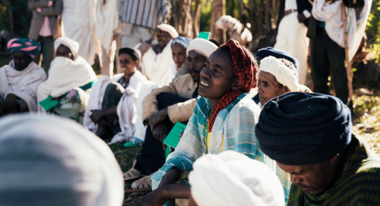Zimbabwe: "Two Years of War in Ukaine and Prices Continue to Rise"
Currency, price and climate crises overlap in the country, as programme director Regina Feindt explains. Generally, the country is able to feed itself – but now El Niño is casting its shadow.

Ms. Feindt, Zimbabwe is one of the poorest countries in the world. The country lacks jobs, foreign currency and energy. What impact does the crisis in Ukraine have two years after the start of the war?
Regina Feindt: Inflation in the country has been high in any case after the government introduced legal measures to encourage the use of the domestic dollar against the US dollar. However, since the war in Ukraine began, the price of bread, for example, has at times risen by 40 percent. The price then fell back to pre–war levels, but for several weeks has been unstable once again, despite government subsidies. 1.10 to 1.20 US dollar for a loaf of white bread, which is not particularly nutritious, is still a lot in relation to average earnings. And prices continue to rise.
Profile
Regina Feindt has been working for Welthungerhilfe in Zimbabwe for about eight years, initially as Country Director, currently as Deputy Director and Chief of Programmes. Previously, she held management positions in Nepal, Myanmar and North Korea. In Zimbawe, rural flight, lack of sources of income and unclear ownership structures are some of the callenges facing agriculture. Almost a third of children under five years of age suffer from malnutrition. Welthungerhilfe has 33 projects which reached about 2,5 million people in 2022.
What about other foods?
Overall, the price level of food in particular is still very high, so I ask myself how people can afford it. Staple foods such as maize flour and cooking oil are subsidized to a certain extent. But these are not high-quality foods for a balanced diet. Pulses, for example, are still very expensive. As well as meat, which goes without saying. And dairy products too. In local currency, prices are rising – albeit more slowly, after some dramatic jumps in 2023 – but they are fairly stable in US dollars. This is due to inflation and the fall in the value of the Zimbabwean dollar. Those who have access to US dollars are better off. But that is only a small part of the population.
Is a doubling of food prices as a result of the war in Ukraine a realistic estimate?
Yes, at least a doubling. The war was an additional factor following poor harvests. In the years 2020-22, there were rainy seasons with longer periods of drought. That always drives up prices. In addition, the economy has been in crisis since the hyperinflation of 2008 and continues to languish. The Corona crisis acted as an amplifier – and the war in Ukraine certainly did too, because the cost of fertilizer in particular has skyrocketed.
International statistics such as Trading Economics continue to attribute the third highest inflation rate in Africa to Zimbabwe at 38 percent, behind Egypt and Sierra Leone. How does that feel when living in the country?
This is a so-called blended inflation of US dollar inflation and Zimbabwean dollar prices. The country has to import a lot because the economy is still at rock bottom and doesn't produce much itself. Due to the war, prices in US dollars for many goods have risen internationally as well, and businesses have to buy US dollars at the unofficial rate to supplement dollars they receive at the official rate in order to be able to pay for imported goods. This means that prices are usually calculated on the basis of the black-market rate and are thus passed on to the consumer.
Prices change constantly, some daily, some weekly, some fortnightly – electricity, for example. In supermarkets, goods are sometimes no longer labelled at all. The local currency is mainly used for digital payments because there is not enough paper money available.
The early warning system for food insecurity FewsNet reported extreme price rises for maize and maize flour towards the end of 2023. This is the staple food for the poor. How did this happen?
We are in the so-called lean season: the produce of the last harvest has been eaten up, as it were, reserves are exhausted and storehouses empty. Under these circumstances, even imports may become necessary. That's why prices soar. The main harvest time for maize is April. Many subsistence-based households in less productive areas are running out of money to buy supplementary food on the market. Regions approaching a state of crisis are increasing, according to the latest warnings from FewsNet's Food Barometer.
According to the reports, dollar prices for maize rose 75 to 100 percent between November and mid-December, with a 17.5 kg-bucket of corn costing as much as 12 US dollars in some markets. Maize meal is becoming the staple food for poor households in most areas, and prices have risen by 20 to 50 percent in US dollar terms over the same period.
The early warning system also expects the cost of living to continue to rise. Do you agree with that?
Yes, I have a similar view. According to the reports, the local currency, the Zimbabwean dollar, lost 50 percent of its value in January alone. Prices for basic foodstuffs and other everyday necessities are rising sharply. Increases in US dollar prices for some goods – in some cases by 30 percent – have been attributed to higher production and transportation costs. The statistics authority reported an annual inflation rate of 34.8 percent in January; in local currency, the cost of living rose by 45 percent in one month – and by almost 600 percent compared to January last year.
How are people coping with this?
Devaluation and the explosion of prices are impacting households earning local currency particularly hard. They are suffering particularly from rising dollar prices – above all because the lean season is reaching its peak and their own food reserves are running out. Many are turning to the informal market. If it should turn out that the El Niño season actually leads to crop losses, people will certainly also try to hoard food in order to avoid price rises due to inflation.
What role does such panic buying play?
The vast majority cannot afford panic buying on a large scale. So it would probably be the middle classes in the cities. But market observers are warning that increased panic buying by households and traders too early in the season could clean out the market for cereals. This, in turn, would cause prices to rise.
What else can be said about the supply situation in the country?
The supply situation was still relatively good in the fall. It was possible to replenish stocks. The previous harvest was good, especially for irrigated crops, but also for wheat, maize and soybeans. In the election year, there was plenty of electricity, and thanks to a good rainy season, dams and reservoirs were full. Whether irrigation takes place – and thus whether there is an abundant harvest – also depends on fuel prices. Towards the end of 2023, drought and temperatures increased to such an extent that many farmers could only prepare their fields for the next harvest late or not at all. This shortens the cultivation period.
What is the outlook for agricultural production?
Our major concern is the El Niño year. Below-average rainfall is expected from January to March. If things go badly, there is a further risk of longer periods of drought, which would once again lead to crop failures and less feed for livestock. In autumn, government and aid organizations ran precautionary programmes advising farmers that due to the delayed rainy season, it would be better to sow millet or sorghum, which are more drought-resistant, instead of maize. Farmers who had already sown in November will most likely have had a total loss if they could not afford a second sowing at the beginning of the year.
But actually, at the moment it doesn't look too bad. Almost nationwide, the countryside is relatively green after three to four weeks of rainfall. These were late but very good. Unfortunately, there were also floods in some places and roads and bridges were destroyed. The danger now is a prolonged dry period: Then young plants will wither, which would be catastrophic. But a definite assessment will probably only be possible in March.
How is government reacting to the price and climate crisis?
In the new government, the Minister of Agriculture has remained unchanged, as have two of his deputies. This continuity is to be welcomed. In November, text messages were broadcast to disseminate information about rainfall forecasts. Warnings were issued that imminent rainfall was due to a small area of low pressure only and did not yet herald the beginning of the rainy season. This was followed by a few very hot weeks where everything withered. The government is also training extension officers to work with farmers in the districts. Welthungerhilfe has set up digital communication channels with the farmers, often via WhatsApp groups, so that information reaches every last corner.

Devaluation and price explosions are especially had to bear for households receiving their income in local currency.
Regina Feindt, Deputy Country Director ZimbabweAre there any special government programs with the start of the lean season in January?
There are aid programs for the poorest during this time, both from the government and the World Food Program. They coordinate the distribution of food or cash vouchers, so that people can get or buy food. The Ministry of Agriculture organizes the distribution of seed. There are programs for the poor, but also for small farmers who are then supposed to sell their harvest to the state grain storehouses in order to replenish reserves.
So government is focussing on support for cereals, cash transfers and cash for work as well as school feeding programmes. This does address urgent needs but there is criticism that the aid flows are not transparent and difficult to trace, as regards both the insufficient provision of funds as well as the selection criteria for recipients. In addition, these measures may address symptoms but are not effective enough in addressing the causes of poverty and malnutrition.
As a result of blocked Ukrainian grain exports and a global rise in prices for inputs and fertilizers, there were fears of that the number of people suffering from hunger would rise worldwide. Was this the case in Zimbabwe?
That always depends on the size of the harvest in April and May. It was comparatively good last year, and the number of people who needed food aid fell as a result. According to information from Reliefweb, which is based on local estimates, around one in four rural households will experience a grain shortage in the most food-insecure period from January to March 2024. This means that around 2.7 million people will need about 100,000 tons of grain in aid. This corresponds to the proportion of people with little or no land whose harvest was – for various reasons – rather poor last year, including widows and orphans and people with physical disabilities.
How dependent is Zimbabwe on food imports?
The price of cereals in Zimbabwe is insanely high, about 30 percent higher than in neighboring countries, and one has to wonder why that is the case. It is set by the Ministry of Agriculture. Perhaps higher fuel prices are also having an effect. Farmers are happy, of course, but consumers pay a higher price. At the same time, there are reports that wheat is being bought in Zambia and sold here at a 30 percent profit.
For staple foods such as maize or other cereals such as sorghum and millet, domestic supply should be sufficient in years of good rain. Additional wheat has to be imported because the varieties produced here are not of sufficient quality and have to be supplemented by varieties with a higher gluten content. Some cooking oil has to be imported, although the government is massively promoting the domestic cultivation of sunflower and soybean in order to boost oil production. Sunflowers are quite drought-resistant and are ideal for dry years without irrigation. There has been some improvement in milk production in recent years thanks to a number of EU-funded programs, but milk powder is still being imported.
Has the government's political proximity to Russia, a leading producer of fertilizers, benefited the country?
The government has sided with Russia and is also being supported by Moscow. But how exactly? That is unclear. Large cargo planes and other goods are coming into the country, but probably also agricultural products. President Lukashenko of Belarus also visited and promised help for the agricultural sector. Tractors are said to have arrived. Perhaps that helped to contain problems to a certain extent. However, cooperation between the two countries appears to be based on the strategic interests of Russia, for instance its involvement in mining, rather than on the sustainable development goals of Zimbabwe. But 2023 was also an election year and there were massive subsidies.
Such as?
Suddenly there was investment in the social sector. A great deal of technical equipment and medicine was purchased for a large hospital. It is difficult to say whether fuel was subsidized. But fertilizers have always been very expensive. There is the so-called 'Presidential Input Scheme' and a program run by the Ministry of Agriculture that allocates inputs to farmers, including some free fertilizer. As a result, farmers commit themselves to a certain extent to deliver their harvest to the Grain Marketing Board. This is certainly a political instrument, but also a way for farmers to obtain at least some inputs at low cost.
Has the fuel and energy supply deteriorated?
The cost of petrol has normalized somewhat, but is still above pre-war levels. And gas for cooking is still relatively expensive. In the area surrounding Harare, the level of deforestation has reached alarming proportions. In the winter months, this was clearly noticeable in the air pollution in Harare. Thick layers of smog hung over the city. Many families can no longer or no longer want to pay for gas and wood as fuel for cooking, especially as school fees and life in general have become more expensive. As a result, trees are indiscriminately cut down and sold.
The power supply in Harare was very stable during the election year, but deteriorated significantly by December. Now, at the beginning of the year, it is fine. However, there are power cuts several times a week, sometimes lasting twelve hours or longer.
How does this relentless crisis affect patterns of migration?
Many people are seeking their fortune elsewhere because of the high cost of living in the country. There has been a massive brain drain in the medical and education sectors. This exodus is very worrying. People who enjoyed a reasonably good education are welcomed with open arms in many countries – and the level of education here is very good. But it has also deteriorated significantly over the past 20 years. So there are major risks in the longer term. What will happen if in ten years' time there are no people left who could help to reinvigorate the country's economy?
Interview conducted by:



